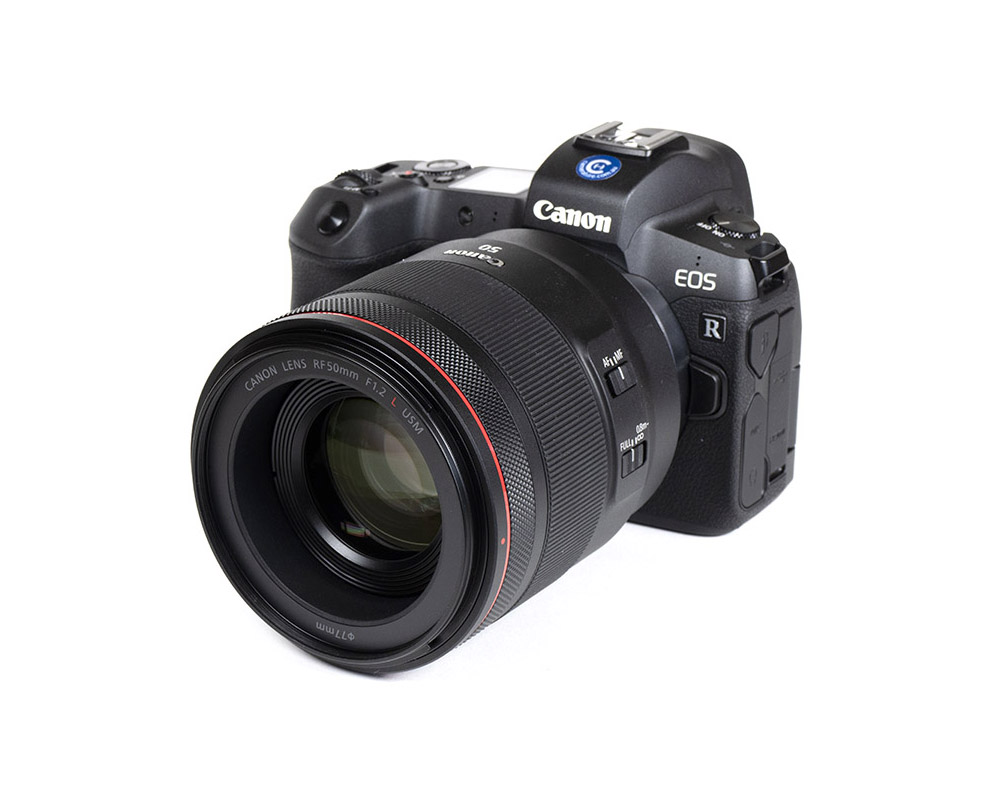Introduction
It took us a little way (as always), but it is finally here – the review of the first Canon RF that came into our lab, the Canon RF 50mm f/1.2 USM L. Unless you lived behind the moon for the last few months, you probably know that Canon released its first full-frame mirrorless system at the Photokina 2018 (trade show). Now Canon wouldn’t be Canon if they didn’t have something for showing off, and besides a monster of a zoom lens (RF 28-70mm f/2), they decided to go for something they are known best for – an ultra-high speed prime lens. Now that alone is not that unique, actually – the Canon EF 50mm f/1.2 USM L has been in the DSLR lens lineup for years (and some may even remember the EF 50mm f/1 USM L). However, unlike that DSLR lens, the RF 50mm f/1.2 USM L has been completely redesigned, featuring no less than 3 aspherical and one UD element.
Unfortunately, that also translates into a much higher price tag. The RF lens is currently selling around 2300USD/2500EUR whereas the EF 50mm f/1.2 USM L is available for almost half (…) of that.
The build quality of the Canon RF 50mm f/1.2 USM L is exceptional. The body is made of a combination of metal and high-quality plastic parts based on a metal mount. It features a weather-resistant design that protects against dust and moisture. There is, however, an inner lens tube that moves during focusing. The focus ring operates smoothly. On top of that, Canon incorporated a secondary control ring at the lens’ front. It can be configured to various functions like e.g. exposure compensation or aperture control – and it even clicks. Think of that … a Canon lens with an aperture ring. How long ago did we see this the last time? That was during the dark ages. Of course, all that can also be controlled on the camera. A deep petal-shaped lens hood is part of the package.

The AF performance is, of course, always heavily dependent on the camera. However, the EOS R and the RF 50mm f/1.2 USM L with its Ring-type USM deliver quite snappy and silent performance. Manual focusing works “by wire”. The focus action is very precise and amongst the best that we’ve seen in a mirrorless system. Full-time manual override is also possible. Some users may miss a distance scale on the lens, but there’s one in the viewfinder/LCD.
| Specifications | |
|---|---|
| Optical construction | 15 elements in 9 groups including 3x aspherical & 1 UD elements |
| Number of aperture blades | 10 (rounded) |
| min. focus distance | 0.40m (max. magnification ratio 1:5.2) |
| Dimensions | 89.8 x 108mm |
| Weight | 950g |
| Filter size | 77mm |
| Hood | petal-shaped (bayonet mount, supplied) |
| Other features | weather sealing, configurable control ring, fluorine coating |
Distortion
Fortunately, Canon did not follow the recent trend of relying on digital post-correction regarding image distortions. The amount of barrel distortion is very low (0.2%) and nothing to worry about.

Vignetting
Ultra-high-speed lenses produce quite some vignetting on full format sensors and the RF 50mm f/1.2 USM L is no exception to the rule here. At f/1.2 the vignetting exceeds 3EV (f-stops), which is, of course, easily visible. For some, this may be an issue, whereas others may actually prefer such an effect. Stopping down to f/1.6 and, more so, to f/2 reduces the issue substantially, albeit there’s still some light falloff visible. Traces remain at f/4 and beyond.

Of course, you can activate vignetting auto-correction on a Canon camera as well. If so, the vignetting is greatly reduced at f/1.2 and pretty much gone from f/1.6 already (at the cost of increased corner noise).
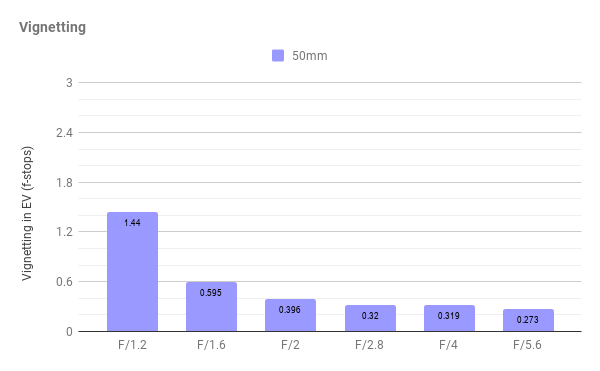
MTF (resolution) at 30 megapixels
The Canon EOS R is no megapixel monster at just 30mp, and the RF 50mm f/1.2 USM L is having that sensor for lunch. The center performance is already near the sensor’s capabilities at f/1.2, and stopping down does improve the quality only marginally from here.
The near-center quality is almost as good. There is, of course, a bit of drop at the image borders/corners, but it’s massively better than its older cousin, the EF 50mm f/1.2 USM L. here. The resolution in the outer image field is already very good at f/1.2 (just). The borders are receiving a boost to excellent levels at f/2, and even the corners can make it there between f/4 and f/5.6. Relevant diffraction effects don’t set in prior to f/11.
The centering quality of the tested sample was very good. The field curvature is low.
Please note that the MTF results are not directly comparable across the different systems!
Below is a simplified summary of the formal findings. The chart shows line widths per picture height (LW/PH) which can be taken as a measure of sharpness. If you want to know more about the MTF50 figures, you may check out the corresponding Imatest Explanations

Chromatic Aberrations (CAs)
Lateral CAs have an average width of around 0.5px at the image borders. In this megapixel class, that’s pretty good and doesn’t disturb, really.

Bokeh – Basics
Sharpness is one thing, but you really invest in such a lens for its bokeh capabilities (out-of-focus rendering). The results are – mostly – great again here.
Let’s have a look at the quality of out-of-focus highlights first. In the image center, they are nicely rendered with a smooth inner disc. The circular shape remains intact at f/1.6, but you can already spot the first aperture edges at f/2. This is fairly “early” and quite surprising given the fact that the lens features 10 aperture blades.

As far as the general blur is concerned, it’s smooth both in the image foreground (to the right below) and background (to the left).

Bokeh – Cat’s Eye
Starting with this review, we are also providing a “Cat’s eye” test for high-speed lenses at least. As mentioned above, the out-of-focus highlight disc are quite nice in the image center, but they are (always) deteriorating towards the image corners This is vignetting effect due to the physical limits of the lens barrel. The image sequence below gives you an idea of how this effect starts at f/1.2 and how the border/corner highlights improve when stopping down.
Note: You may spot that the highlights have a graduated inner zone at f/1.2 and, a bit less so, at f/1.6. That’s a flickering effect from the light source. At f/1.2, the shot was taken at 1/4000sec.



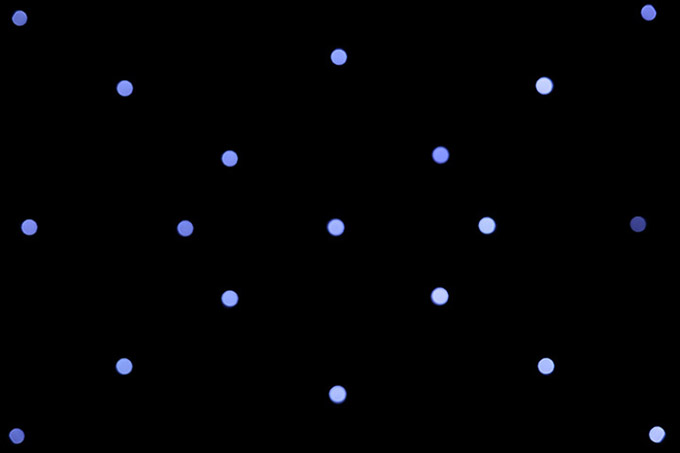
Bokeh Fringing
In a perfect world scenario, you won’t see any axial CAs, thus color fringing on the Z-axis. However, only a handful of fast lenses are correcting the issue effectively. The Canon RF 50mm f/1.2 USM L is actually ALMOST there.
At f/1.2, you should be able to spot the usual purplish color fringing in front of the focus point and a greenish halo beyond. However, the fringing is almost gone at f/1.6 already – which is very impressive.
You should also be able to notice that the focus point does NOT shift when stopping down when selecting different apertures below. Many high-speed lenses have difficulties keeping the focus point spot on. Technically, these focus shifts are called Residual Spherical Aberrations (RSA).
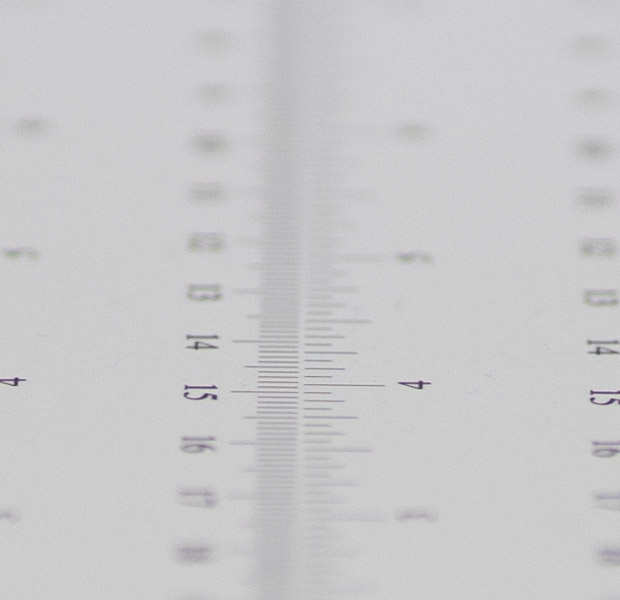

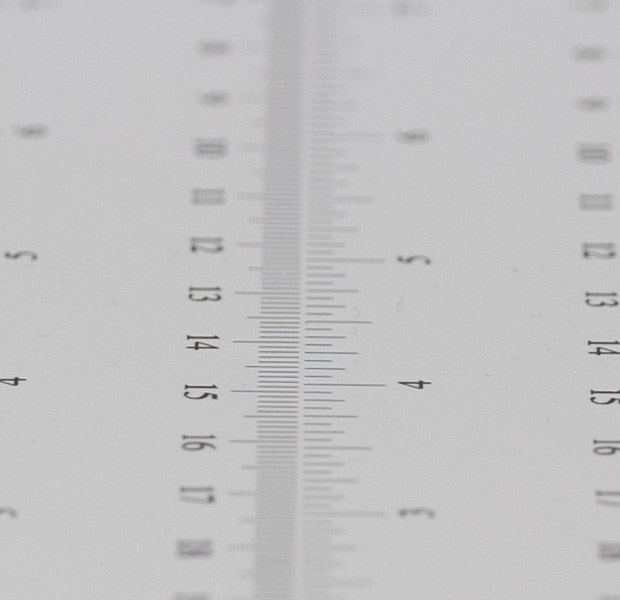

Sample Images
Competition
As of the time of this review, there are only a handful of native RF lenses available so competition doesn’t really exist. If you really want to go down the dreadful route of using a converter for using Canon EF lenses, you could use all/most of these lenses, albeit this remains cumbersome as all adapter solutions. You could also use the already mentioned Canon EF 50mm f/1.2 USM L, but you shouldn’t go there, really. The Canon RF 50mm f/1.2 USM L is a magnitude better, really. From a value perspective, the Sigma 50mm f/1.4 HSM DG ART may be interesting but then again – what’s the point of using an even bigger lens on a smallish camera? That would somehow defy the purpose of choosing a mirrorless system in the first place. If you haven’t decided to go for a Canon R yet, it is, of course, worth taking Sony into account. Sony/Zeiss are offering no less than 5(!) 50mm(-ish) lenses for Sony E mount by now. The Zeiss FE 50mm f/1.4 is a little slower but it’s also a magnitude more affordable than the Canon lens. We haven’t tested this one yet, but we heard good things about it.

Visual comparison courtesy of camerasize.com.
Let's start with a disclaimer: Any verdict has to be very preliminary at this stage - it's our first review using the EOS R, after all. Also, keep in mind that the 30-megapixel sensor is rather average in terms of resolution today.
That all being said, it is quite obvious that the Canon RF 50mm f/1.2 USM L is an awesome lens ... with a similar awe-inspiring price tag. In relation to other lenses in this class, the performance is already superb at f/1.2. Yes, the outer image region is not truly stellar, but it's impressive nonetheless. The image quality is extreme at medium aperture settings - across the image frame, that is. Low lateral CAs contribute to the very high image quality perception. Image distortions are generally no issue. Vignetting is, though - at least in its uncorrected state. There is some heavy light-falloff at f/1.2 and f/1.6, but to be fair - that's to be expected.
Most users will not (should not?) buy the lens for its sharpness but for its shallow depth-of-field capabilities. While not truly exceptional, the bokeh is very good, with a smooth rendition in the focus transition zone. Out-of-focus highlights are nicely rendered in the image center, less so towards the image corners. However, that's a physical limitation really. We were also very impressed by the very low bokeh fringing. Yes, you may spot some traces at f/1.2, but it's not really relevant anymore from f/1.6 onward - and that's a very rare characteristic. Thumbs up for that.
In terms of mechanical qualities, there are no real weaknesses. The lens is built to professional standards, including weather sealing. The AF is surprisingly fast thanks to Canon's dual-pixel AF and the Ring-type USM drive in the lens. You won't really miss a DSLR in this respect (in this specific case, at least). Unlike on DSLRs, you also don't need to worry about AF accuracy anymore. You may think that the additional control ring at the front of the lens is a bit of a gimmick, but it has grown on us during our field trip.
Given its optical and mechanical qualities ... as well as its uniqueness in the EOS R system ... it is, of course, easy to highly recommend the Canon RF 50mm f/1.2 USM L ... assuming that you can afford it at least.
-
Optical Quality (30mp)
-
Build Quality
-
Price / Performance


